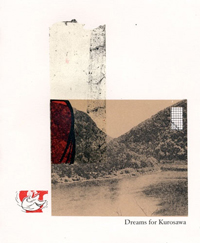 Dreams for Kurosawa
Dreams for Kurosawa
by Raúl Zurita / translated by Anna Deeny
arrow as aarow , 2012
$10 Buy from arrow as aarow
I would like you to see how I’ve scratched and bent and battered this beautiful book. I have been holding this bark relatively near to my person for almost every day of the past few months. (I don’t go to the wheezy bar or to the co-op or to any grass just outside without some kind of bike bag growing out of my back. It rains on the way. There was an angry spill in August.) Do you think it’s still in a magical shape this way? I do. I thought I might want to write something about Raul Zurita when I got Dreams for Kurosawa in the mail, and I kept waiting for the bones of the poetry to dry out. They still haven’t. They drip on me. “Once again I see the worlds,” says a line in poem simply called #2 that I repeat to myself like tattoo berries.
 Being near poetry means clanging mis-remembering and remembering together into brackish jewels. Both make the cardboard around us shine. In the case of Zurita, we have some kind of glimpse of where the lines between a real event and the logical leaps writing causes the brain to take exist. If you are familiar at all with the shapes that pus in and out of Zurita, you know he is a Chilean poet who writes primarily about surviving Augusto Pinochet’s atrocity-ridden coup d’etat in 1973. You know that his life is a circle of hinges burning around the real sadness it was pulped into. “I was seized by the Arauco brigade and before/dying I remembered the worlds” (#2). During the coup, Zurita was detained in the hold of a ship with a thousand others deemed enemies of the new military government. (He was carrying poems at the time, which were thrown into the water by a soldier. Those poems are his book, A Song for His Disappeared Love.) Over 30,000 people are estimated to have been tortured and a little over 3,000 killed during Pinochet’s time at the helm.
Being near poetry means clanging mis-remembering and remembering together into brackish jewels. Both make the cardboard around us shine. In the case of Zurita, we have some kind of glimpse of where the lines between a real event and the logical leaps writing causes the brain to take exist. If you are familiar at all with the shapes that pus in and out of Zurita, you know he is a Chilean poet who writes primarily about surviving Augusto Pinochet’s atrocity-ridden coup d’etat in 1973. You know that his life is a circle of hinges burning around the real sadness it was pulped into. “I was seized by the Arauco brigade and before/dying I remembered the worlds” (#2). During the coup, Zurita was detained in the hold of a ship with a thousand others deemed enemies of the new military government. (He was carrying poems at the time, which were thrown into the water by a soldier. Those poems are his book, A Song for His Disappeared Love.) Over 30,000 people are estimated to have been tortured and a little over 3,000 killed during Pinochet’s time at the helm.
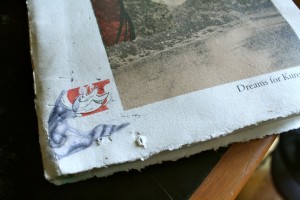
The bodies were dumped into the sea from government planes. They were shot up with chemicals meant to cause hyper decomposition and tied to old railroad tracks to ensure the kind of sinking meant to be erasing. Physical blood and pain are how the paper is a solid for Zurita. When Zurita writes, he writes the impacts felt inside a tangible hell. He writes through a ghost rain and through skin. He talks to the sea like it is blood.
upon millions of faces with their mouths open,
infinite hips, arms and legs sweeping again and
again the beach as if painted ropes. Kurosawa. I
managed to cry out, this isn’t a dream, this is the sea.”
(For Kurosawa/The Sea)
The poems of Dreams For Kurosawa also have their scabbed roots wrapped up in a mistake. Zurita wrote to translator Anna Deeny in an e-mail, excerpted in an essay, “Love in the First Person,” written by Denney and located at the back of the book,
 This is a mistake you know. This book lifts itself up from the feeling that a book/a film (in this case)/a song/a shard you’ve just received some real heart steam from is something that’s been an old cave inside you for however long your heart has been around and working pretty okay. You feel and you wonder how you ever were not with whatever chunk of human guts it is, how it ever wasn’t a part of your surviving. You know that you are witnessing something that was made from the earth’s original teeth, that you will speak larger from now on.
This is a mistake you know. This book lifts itself up from the feeling that a book/a film (in this case)/a song/a shard you’ve just received some real heart steam from is something that’s been an old cave inside you for however long your heart has been around and working pretty okay. You feel and you wonder how you ever were not with whatever chunk of human guts it is, how it ever wasn’t a part of your surviving. You know that you are witnessing something that was made from the earth’s original teeth, that you will speak larger from now on.
Zurita’s own experiences, name, memory, and hallucinations cause him to do something more interesting in Dreams for Kurosawa than boil down the cruelty of what happened to him and the other bodies to understanding. Poetry holds him to boiling out, to cultivating voices. The opposite of a dictatorship runs the poems of Zurita. Other artists live here (Akira Kurosawa, other South American poets), Zurita himself, pieces of family, women that were long-haired. The names (real and fake?) of those who died in ‘73 grab a voice and pipe up. Most importantly, Zurita is a writer who looks at the real and the imaginary (at the world of the living and the world of the dead) with the same urgency. “As I opened/ my eyes my small body floated at the base of / the falls, and it wasn’t a dream Kurosawa because/ the waters were tearing me apart” (#4). Both dream and reality are necessary for survival, and they appropriately complicate Zurita’s sense of having survived. “As I opened my eyes above me I saw the dizzying/ white of the summit and much further below the first/ light of the city illuminating. Only then could I cry” (#12/Papa has Returned). Both are necessary for speaking and in the search for, as Denney points out, “the possibility of something that is greater than death.” Poems like this live off of adjusting boundaries for the long or the short or the fall term, by reveling in mess fluids, by treating the blurs in lines as tools capable of revealing how deep language can open for core samples.
However, the difference between Zurita and the tradition of an author seeking immortality through writing is that Zurita is not interested in his death or his immortality. He is interested in the possibly more impossible task of humming the other dead and the other outside him. “This concern for the other’s death as greater than one’s own,” Denney says, “constitutes Zurita’s idea of love.” Zurita is the man who thinks love can really be that big inside (I heave while I read in an attempt to try and feel the length with my own arms) and spring to life outside the poem, that he can kill this many totally reasonable barriers. Zurita is thinking, in this book, of the blue faced Japanese soldiers in a vignette of Akira Kurosawa’s film, the ones who don’t know they are dead, but who continue to language at him/us.
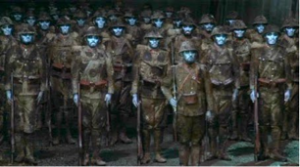
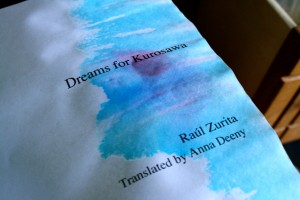
Zurita is the man who tried to convince the Chilean Air Force to write poetry in the sky. Zurita bulldozed a poem into the sand of the Atcama desert. People who are not Zurita still protect it. In his Kurosawa poems, the many throated speaker sees poems coming out of cliffs.
walls and a thousand meters below, the Pacific.
I had imagined lines written upon those massive
walls, exactly twenty-two of love, of madness,
and death incising into them.”
(Was It You Papa?)
And Zurita’s guts barely quiver. When you read him, you feel a lessened sense of fear, se-consciousness, sometimes I’m sure it is even an absence of it, regarding whether or not the poem can do what he imagines it to be capable of. “As I opened my eyes I/ saw the transparent mountains and closer yet,/ infinite red flowers emerging from the snow as if/ they were blood entrails” (#10). The place that digs out of this book adds new kind of texture to suffering/poetic coping/poetic impulses. The suffering individual lingers, receptors out, in the space between itself and those it can’t save or touch. It lingers between life and life elsewhere and death, feeling for the potential stuff of braids, for the touch that happens nonetheless. “Disaster ruins everything,” says Maurice Blanchot in The Writing of the Disaster, “while leaving everything intact.” When Zurita writes, jungle animals end up on the inside of the desert’s edge and mountains to stick to our ankles like burrs. The poem mows this way it is tangled. The limbs of the poem, which are made of odd rocks, and maybe even the wrong rocks, move all of their striations. “The infinite/ luminous lines continue crisscrossing themselves as if / the whole earth were the bottom of a pool…” (#5). Our sense of relief/release as readers comes from clutching the unbearable as it blooms and blooms rather than through some kind of “clarity.” It all feels a recognition that the world filled with us doesn’t hold still, that it grows skins that break and shatter wind around us constantly. The world, as it stands, is a start square, a startling square.
Zurita’s hardened tissues gather color through these poems, through any place that has words for them to juice through. They learn to feel again and to feel more. We, as readers, grow a way to listen and receive that is difficult to hold without feeling an overwhelming weep thunder through. It fills us with the urge to feel something that walks more than hope. We have the urge to do the opposite of collapse after Zurita, even though collapse is certainly what happens. We have a rage of the senses. We become a torrent of the dead, a torrent of voices, and in some way, as did Zurita when he mistakes when and where he saw a powerful film, we become unheeding of lines (like time) that would make us unable to do so. We listen as he s(retches) across the ocean and calls Akira Kurosawa, who is us, who is the filmmaker who also experienced the suffering of others during WWII and more specifically, Hiroshima, who was also surrounded by the sea. “What the fuck dream of Beethoven in the middle/ of the desert Atacama” (#6), yells the polymorphous narrator. The one who is capable of writing or filming, the one who is dead, the one who has a language, it is the same ongoing face. The most significant party of where we live is dirt on everything, is blood hugging everything, is bent pages, is building a landscape, a place that is more than a space, where the dead and the living wait and are pregnant with breath.
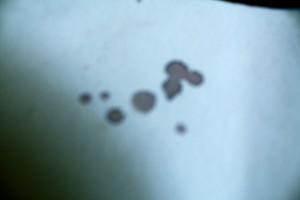
(blood)
***
Carrie Lorig lives in Minneapolis, MN and wishes blood had a sound.
Tags: Anna Deeny, Carrie Lorig, Dreams for Kurosawa, Raúl Zurita

Thanks. http://www.youtube.com/watch?v=v6qvIhygLTs